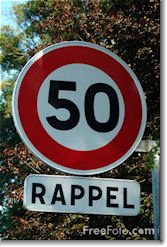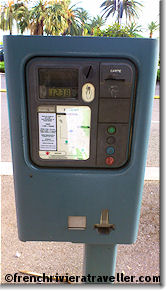The flexibility and convenience of car travel can make it worthwhile to rent a car on the French Riviera. Plus, there are some incredibly scenic drives (see the Corniches) where the splendour of the coastline can just take your breath away. If you plan to visit several hill towns, a car is much more practical than a bus as buses to villages are inconvenient.
On the down side, traffic can be a nightmare, especially along the coastal roads and in town centers. Try to avoid rush hours of course which are between 7.30 and 9.30am and again between 4.30 and 7.30pm.
Parking is also a huge problem. Free parking is almost impossible to find and parking garages are frequently full. Paid parking on the street can also be extremely difficult to find. Paid street parking is indicated by broken white lines. Should you find a space, park your car, look for the nearest horodateur, pay for the amount of time you need, take the ticket and put it in the windshield of your car.
To make your life easier, I recommend renting the smallest car possible. First, you can squeeze into tight spots and second because parking garages allot very little space per car. The slots are unbelievably narrow.
Check out great deals on car rentals
I also recommend renting a car with GPS. Roads developed helter-skelter in this region with no apparent pattern. There are a plethora of one-way streets and destinations are not well-signed.
Cote d'Azur drivers are known for their agressive, sometimes demented driving. If you do rent a car, drive defensively and consider the following:
Drive on the right side of the road.
Seatbelts are compulsory for all passengers.
Children must be over ten years old to sit in the front.
Alcohol is limited to 0.05 g/l (one to two glasses of wine).
Priorité a Droite means that priority goes to the driver on the right. On main thoroughfares you do have the priority but at the intersection of small roads, yield to the driver on the right.
In case of accident, dial 17. All parties fill out a constat à l'amiable; these blue papers are provided with your car rental and must be kept in your car.
An international driving license is not required to drive in France. A valid driving license from your home country is enough. Note that even local gendarmes have an acquaintance with English which is a good thing if you need to explain the details of a traffic accident but a bad thing if you think playing the dumb foreigner will get you out of a speeding ticket.
Along the autoroutes the maximum speed is 110km/hour. Within cities or towns, the limit is 50km/hr and roads connecting towns will normally have a speed limit of 70km/hour. Speed limits are posted. The sign "Rappel" is not inviting you to participate in a sport; it means "remember" and is there to draw attention to the speed limit.
The French government has recently implemented a crackdown on speed-driving with spot controls and stationary radars hidden everywhere. In addition to radars checking for speeding, there are also radars at certain intersections that check for running a red light. For a map that shows exactly where the radars are, click here. Fines for exceeding the speed limit begin at €90.
Spot controls are more frequent on weekends. Check the Friday editions of local newspapers to find out where they are.
The main highway that runs the length of the Cote d'Azur from Toulon to Menton is the A8 autoroute and it is run by Escota. There are toll booths set up at each exit; payment is made either with coins or by any credit or debit card with a magnetic strip. As an example, taking the autoroute from Nice to Cannes costs €2.90 in tolls. Unlike toll roads elsewhere, there is no entrance ticket. You pay as you go.


Horodateur